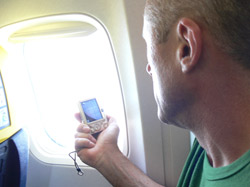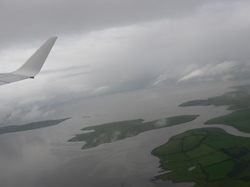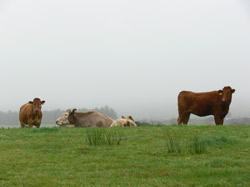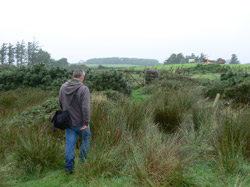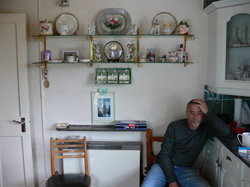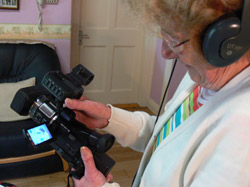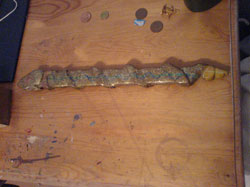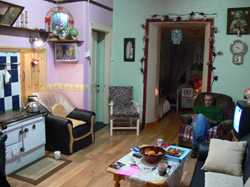
Image/Sound/Text:
"Can you stop clicking, Patrick?": Thoughts on a Transvisual Ethnography
“Can you stop clicking Patrick? One thing at a time; you can do that later can't you?!”
It is only in retrospect, watching over the rushes of a video interview I shot with the mother of Patrick Tubridy - long term Tate Encounters participant - that I realise the absurdity of the comment I made to Patrick: “Can you stop clicking…” The clicking of his digital camera in the background had begun to slightly irritate me, as it was 'invading' the interview, and making it less 'neat', with lower 'production values'. In my practical training as a Visual Anthropologist, I was taught basic film making ‘rules’ to achieve the best results, such as ensuring the absence of background noise when somebody is speaking to the camera in order to make editing together parts of the conversation easier. I have a preconditioning that all background sounds are something to be removed. What I overlooked in that moment was that Patrick, as a Digital Photographer with his own interest in the theme of generational experience of (visual) culture, would naturally wish to document and investigate that moment with his camera, as he had done throughout the project.
The conventional conditions of filming are also challenged in this particular ethnographic context when one considers that in the Tubridy household, Patrick’s mother has the radio on all day (and sometimes the TV on simultaneously) to replace the sounds of the busy family life that used to exist in that space, as silence now makes her uncomfortable. Her auditory landscape is as much a 'fact' as anything observable, so one is forced to consider how viable it is to turn off the radio or TV when talking to her, given the themes we are researching. It is akin to rearranging/ removing some of the pictures on her wall to fit the codes and aesthetics of a value system alien to what I am experiencing in the field.
1. Introduction
I have opened with a discussion of two examples of experiences from my most recent fieldwork in Ireland with Patrick Tubridy and his mother that challenged my ideas about my practice as a video ethnographer. They made me consider the implications of the insertion of visual digital technologies into the ethnographic moment, the relationships between the lens, the co-researcher and the ethnographer that result from that insertion, and the ways in which such questions may help me to reflect on what transvisuality means.
In the visual essay that follows I shall elaborate on the work involved in the ‘families ethnography’ described in [E]dition 3, using, as an example, the context of one particular ‘families ethnography’ – that of Irish co-researcher Patrick Tubridy. The text shall be interspersed with photographs and video clips from footage shot recently during fieldwork at Patrick's birthplace in Ireland, as well as interview and workshop footage shot at Tate Britain over the course of the project. It will also incorporate his own reflections on the fieldwork and the questions it has raised for him.
The clips and images shall be used to describe the various stages of this type of fieldwork. I shall look at the ways in which the fieldwork is allowing me to examine how generation and gender impacts on the experience and creation of visual culture – the primary aim of the ‘families ethnography’ in relation to the research questions. Presenting the data in this way, I can also start to make links across time and space with a view to working the footage that I have captured into an ethnographic film for viewing at a later stage. The clips in this context are not intended to be viewed as films but as visual records from the field. In line with this I have entitled them with the information from the label on the tape onto which I recorded.
2. Reflections on a [Trans]Visual Ethnography
The Tubridy ethnography is particularly interesting in light of the ongoing discussion in the [E]ditions about ‘transmigration’ and its associated modalities of spectatorship – something Dibosa (2008) has called transvisuality.
Patrick’s own focus of research has been the transmission of culture (visual and otherwise) across three generations of his family, within which he was the transmigrational individual. He is particularly interested in the extent to which his own father’s influence has been passed through him to his son Rhys who has never lived in Ireland. He has also focused on his professional training as a Digital Photographer. He has employed digital imaging tools in various ways to carry out his research. I wish here to illustrate the central role that the camera plays in Patrick's visuality, or more precisely transvisuality. I also aim to elaborate also on my own visual practices. I want to examine how both of our visual practices have played into the dynamic between me, him, my camera and his camera and the subsequent results of this dialogic collaboration.
I shall also reflect on how I feel my own experience of being a transmigrational person has aided my ability to respond to a variety of fieldwork situations, and how the insertion of digital visual technology (video and photography) into the ethnographic context gives rise to particular sets of data and creates a particular kind of constructedness – of both the ethnographic moment and the visuality employed within it. From all of this, the further questions that arise regarding Dibosa's notion of transvisuality in this specific ethnographic context shall be outlined for further investigation in a subsequent [E]dition.
The comprehensive fieldwork carried out with Patrick, doubled with his own interest in family, generation and transmission of culture in a transmigrational context articulated through his co-research has provided me with a rich pool of data, with which I can trace a significant part of an ethnographic 'loop'. In terms of my methodological structure, the fieldwork in Ireland comprised the middle phase of my ethnography, before the return to the gallery and the continuing research that shall continue until the end of the project.
3. A Starting Point
Ireland Tape 8 – 29.08.08
11.00 Bible - Tate - The Child Samuel
As I outlined in [E]dition 3, my methodology for participant ethnographies consists of a framework of three interviews: one ‘Entry’ interview on commencing their Tate Encounter that relates to the lifeworld from which they are coming as well as the ‘baggage’ they bring to the project (visual, cultural etc.), one ’Lived Experience’ interview at their home or somewhere in their lifeworld relating to everyday visual and cultural practices; and, finally, one ‘Exit’ interview that addresses how their life story and lifeworld relate to the collection, space and politics of Tate Britain, addressing the ways in which this has been played out through their sustained Tate Encounter. In Patrick Tubridy’s case, given that he has participated in a ‘families ethnography’ which resulted in us going to his family home in County Clare this summer, the middle ‘lifeworld’ stage has taken the form of a much more comprehensive visual ethnography.
Earlier in my fieldwork, I had conducted an interview with Patrick during which we talked around some family photographs from his youth. Through those images I became more familiar with his background and the people and places it comprised. During the interview he talked about the significance of the church in his childhood – not as a spiritually formative institution, but rather as his first introduction to art and specifically to the work of the Old Masters, especially through a Bible he had been given by an aunt. This was the starting point to his interest in art and his first introduction to art galleries, including Tate Britain. On our trip to Ireland, he was able to show me this formative book, and the images within it that had stuck in his mind for all these years.
4. Fieldwork – In the gallery
Patrick has been present at many of David Dibosa’s ‘Encounters with Artefacts’ workshops which took place largely within the context of the gallery. He has also frequently visited the gallery independently. A theme that came out of his entry interview and many subsequent conversations is his fascination with History and an emotionally invested interest in Irish/ Celtic history and the legacy of the English in Ireland (and Scotland). Indeed, referring to the power dynamics of the historical occupation of Irish farmland by English landlords, he has often referred to Tate Britain as feeling to him like “The landlord’s house”.
On several occasions, Patrick’s historical knowledge and personal politicised engagement has served as a legitimation/ authentication tool for determining his response to an artwork, which in turn has had an impact on what constitutes a worthwhile visual experience for him. Indeed, in an interview I conducted with him about the various ‘migrations’ he made from his family farmstead to his current life in London, he commented that, “Anywhere I went, history was my tool to get me around.” A recurring response to what he has seen in the gallery is the disjunction between what he knows to be true from his historical knowledge and the representation of those events through the collection. In some cases, the appropriateness of a piece’s inclusion in the Tate collection has been contested, an example of which occurs in the clip that follows, where Patrick responds to The Disgrace of Wolsey by Henry Munro.
David Workshop Series 2 - Tape 1 - 05.03.08
12:00 Henry VIII Propaganda piece
13:30 “As an immigrant looking at this”
5. Fieldwork – Returning ‘home’
Patrick was one of seven children born at Clohanmore - a farmstead in County Clare, Ireland. His father believed in ‘the old way’ of working by hand, even when new farming technologies were introduced, and the family was entirely self-sufficient. Patrick was involved with working the farm, as were his siblings. He went to the local school across the fields, as his mother and father had done. When he reached eighteen years of age, he knew it was time to leave. He did not have a plan and it was a voluntary departure, but as he put it, “It was a choice to leave, but I had to. I had outgrown it.” He initially stayed with family friends nearby. His next move was to Shannon, then later to Dublin, where he spent two years. Dublin was a relatively large city with much to interest and challenge Patrick: “To get into Dublin you had to hang up the coat you had been wearing for eighteen years and get a new one.” It was by no means his final destination: “Dublin was a stopping off point…just somewhere to go”. He subsequently went to London and various destinations in Europe, before returning to London and having a son, Rhys, who he has raised. Rhys is now fourteen and Patrick is expecting his second child, with his second wife.
The next clip is an excerpt from a conversation at a place of ‘spiritual’ significance for Patrick – a place where he feels connected to the ancient history of Ireland. His connectedness, however, makes him all too aware of the lack of connectedness among his friends and relatives who never moved away. He is aware that to leave and to return makes you see things differently.
Let us now consider the working definition of ‘transmigration’ that has been employed by this project – that of movement from one place to another where each ‘move’ constitutes only a part of a series of migrations. According to this definition, Patrick is a transmigrational individual. In addition, I, the ethnographer, am also a transmigrational individual (with an associated transvisuality).
How does this transmigrational identity impact on how Patrick and I might think about ‘home’? It has become apparent over the course of fieldwork for Tate Encounters, just how much my own transmigrational identity has influenced my ability to adapt to various fieldwork situations, and find points of reference in conversations with participants from a variety of backgrounds. It has also helped me to be self-reflexive about my own ways of seeing and my visual ethnographic practices.
My own background is one that has involved a lot of ‘moving between’ and shifting definitions of ‘home’. I was born in Buckinghamshire, less than an hour from London, and spent my early days in suburbia. My family visited London occasionally. When I was eleven, my nuclear family moved to Nairobi, Kenya, due to a career opportunity for my father. This was a huge disruption to my lifeworld and one to which I would take two years to adapt. I lived and was educated in Kenya in an international, expatriate environment until I was sixteen, at which point I returned to England (‘home’) to do my ‘A’ levels – albeit in the artificial, isolated microcosm of a boarding school.
This, of course, was the biggest culture shock of all – the return – as this England did not seem to have much connection to me anymore. Yet, I seemed to have some knowledge of how things ‘worked’ in England, despite only having lived here as a child. Of course, the England I was experiencing through my boarding school was a very different one to the England of my childhood. At that point I began referring to Kenya as ‘home’, even telling people I was “from Kenya”.
Although boarding school to me was a kind of prison, my new life in England afforded me, through security and travel opportunities, an independence I had not previously experienced. Occasionally I would return to Kenya in the holidays. Having tasted independence and how much it taught me, my subsequent returns ‘home’ were stifling. My parents lived in a gated compound with a security guard. If I wanted to go anywhere my mother would have to drive me. When you are an expatriate living in Nairobi, you ‘don’t do public transport’.
Having ‘done’ public transport and navigated myself independently around several countries in Africa and Southeast Asia by the time I was nineteen, I wondered how I remained so affected by the paranoid expatriate mentality towards independent travel (or independent anything) in Kenya: whenever I went ‘home’, I became the person I was before leaving – a regression which highlighted the fact that this was not the person I was now.
To some extent, I also noted a ‘regression’ happening to Patrick when we returned to Clohanmore. He became his mother’s son, and played the role of jovial and responsible family member. He is aware that the older generations (and many of his peers) cannot fathom his interest in ancient history, art and photography, let alone the many experiences his life since leaving Clohanmore has entailed, so he does not attempt to explain its complexities. When showing this ‘home’ to me, it became clear not only how he felt there but the way in which he saw it:
[Patrick Tubridy] as the days went past I realised that when I wanted to explain something, I would refer to what it was like when I was a young man growing up, as opposed to what it is like now.
So from this I realised that the expression that I used when being interviewed, that I live within the ‘echoes’ of the past when I return home, is a good description of how I feel. I have also become an insider/outsider in the place that I have always thought of as home.
Reverting to my own life story, as I continued through university in England and established myself as an independent adult, continuing to travel all over the world, the allure of ‘home’ diminished to the point where I had little interest in returning to Kenya, other than to visit family. I certainly have no wish to live there: I am an ‘outsider’ and I have now realised that I always was. However, it is true to say that I have never felt like an ‘insider’ in England either. Having been exposed to all that I have, it is rare that I feel ‘at home’, whatever or wherever that may be. This is not a disadvantage. On the contrary it means that I can make ‘home’ wherever I am. This state of limbo and adaptability is an attribute which I find to be a useful tool for relating to the participants in this project, perhaps more useful than any other. It allows me to ‘land’ somewhere totally unfamiliar and to be able to respond to it immediately. This project locates me in different situations which are an extension of my fragmentary experience, and through which I move across arcs of meaning and narrative.
Patrick and I have both experienced what it is to be exposed to so many different influences and images while moving through places. We have both become quite different individuals, and adopted new and ever changing ways of seeing our lifeworlds as a result – our ‘transvisualities’. The return ‘home’ is problematic, as ‘home’ is a term one associates with a place one feels oneself, or at least comfortable. For my part, I feel most at home when ‘on the move’ as long as I have a reference point, whether that is in the form of a person, a landscape, or a house.
6. The Insertion of Digital Photography and Video
For Patrick, the concept of ‘home’ and the problems it poses, has led him to look for practical solutions that exploit his limbo status as an attribute, such that it becomes a possible identity in itself which can inform his visual practices. The presence of an ethnographer, with a video camera, brought these ‘problems’ to the fore:
[Patrick Tubridy] Now that some time has passed since my field trip to Eire with Sarah Thomas on behalf of the Tate encounters project, I have had space to reflect on it and hope to put into words the act of being an insider /outsider in the place that I grew up.
Initially I never thought that I would have been so divided in my thinking as I was. But from day one I found that to be interviewed on camera about my birthplace put me in a position of having to be a Londoner explaining and describing what it was like as a child growing up in that place, or a tour guide giving a walk through a lost civilisation’s ruins.
Digital photography has played a multi faceted role in Patrick’s quest to understand his family history. From a technical perspective, it has proved particularly useful in documenting the engravings in some family gravestones only recently discovered quite a distance from Clohanmore, marking the resting place of a part of the family previously thought missing. Some of the engraving is unclear, but Patrick is able to enhance his digital photographs of it in Photoshop to decipher the text. The digital images, and the fact that they could be shown to others on the built-in LCD on the camera provided a means for Patrick to conduct photo illicitation with his mother and other members of the family who might have pieces of information that may contribute to the whole. It also proved a useful evidential tool in an argument between Patrick and his older brother Gerrard as to who exactly was buried there.
In the next clip we see Patrick and his mother take me to the graveyard where a missing part of their ancestry was recently found. They take the opportunity to show me the difference between an Irish grave and the rather more grandiose resting places of British descendants. This difference has clearly left a legacy of oppression sentiment, with them and with the local community, who abandoned it for years. Patrick is still trying to decipher exactly what the engraving on the gravestone says – a task which is aided greatly by his Digital Photography and capabilities with image software such as Photoshop.
As is becoming clear, the digital camera in Patrick’s hands is not merely a means to document certain people/ places/events. Rather, it is an active agent in the process of understanding those places and people en route to understanding himself. At the same time, as a transmigrational person, Patrick has become accustomed to transience and rapid change, especially as experienced in the metropolis of London. The devotion to somehow capturing a sense of 'the old way' at Clohanmore before it disappears is evident. For those who have remained at Clohanmore, life ticks along rather more slowly, and not much happens. For Patrick as a returning visitor, however, he knows his time there is limited and so his photographic response to it as a photographer-with-subjective-emotional-investment in that place in particular is enacted similarly, if not more avidly to the way he photographs less 'familiar' things in the city. In addition, he sees his role as that of an archivist for future generations.
Where do I stand?
The role played by my own lens in this dynamic was as an integral part of Patrick's project to make sense of his family history. The way in which I used the video camera, and myself-with-the-video camera during fieldwork was as an active agent, collaborator, and follower and participant of processes of discovery. My time at Clohanmore was more limited than anybody's and I had to try to understand, illicit and document a great deal of information in a short space of time. Sometimes I was directed by Patrick while at others I stated what we needed to video. At all times, however, it felt more collaborative and power-balanced than any other ethnographic context I have found myself in during the Tate Encounters fieldwork.
The lens was deeply involved this time, and I realised that a lot of the time I was seeing through it as if it was an extension of my eyes. That is to say, I engaged with my surroundings and explored them with the camera. Without the technical constraints of limited power supply, limited tape stock, or unwillingness of participants to be on camera at any point, there was nothing that was not available to be seen with the camera. Not only was it there to be looked at, freely, but as a team were actively trying to uncover many more layers of experience.
Again I had to be prepared at all times for a 'video moment', just as all moments had to be prepared to be videoed. Fortunately Patrick's mother was very comfortable with my presence and let me video freely through the house. It is only through having a fairly intimate prior/ concurrently developing knowledge of the people, relationships, places (including specific sheds and walls) at Clohanmore that this kind of video ethnography was possible. For example, the fact that I had recently watched the family photographs interview I shot with Patrick some months ago, and so could remember the names of all their pet animals from years back, led Patrick's mother to feel that I was already somewhat embedded in the family's story and therefore she was more willing to share more of it . She was also interested to see the footage I had shot, especially of herself. And it is only through being at Clohanmore that I could make links with what Patrick has talked about in interviews and workshops at the Tate. Indeed, having experienced it I am much better placed to make those links.
I also had to make sense of Clohanmore on my own terms, as being there was yet another fragment of my own transmigrational experience. As such I could not only make sense of it through the prism of Patrick’s concerns. When I arrive in a new place, I take time to employ my sensorium (not only vision) to observe details that make me feel located in that place. I was struck by the importance of sounds and smells in creating the rich fabric of 'reality' at Clohanmore. As such, many of my videoed explorations that involved a focus on sensory details did not, indeed could not, involve Patrick’s presence, as with his presence my concerns and attention shifted back to his own narrative (cross generational transmission of culture) and formulating questions to draw that out in this place. To experience the sensuous landscape I had to just ‘be present’, and ask myself, “what do I feel here?”. By “feel” I am not necessarily referring directly to an emotional state of being, although that is intrinsically related to a sensuous response to one’s environment. Rather, I use the term here as a means to attempt to express the response(s) of a combination of the senses, and indeed, from one moment to the next the sensory hierarchy could reconfigure itself.
The digital technologies used in this fieldwork were not there simply as tools to document other activities we were engaged in. Rather, they were an integral part of what we were doing. Patrick, in his role as archivist, regularly recorded conversations between himself and his mother, or other relatives. His camera and my video camera had a ubiquitous presence and much of what we did was based on the knowledge that we were going to use them. As such, the insertion of these technologies into the ethnographic moment gives rise to a constructed visuality. Our respective visualities are also sites of ethnography when we talk about what we have captured/ want to capture and why.
7. Moving between and new ways of seeing
[Patrick Tubridy] the description I have used for myself - as being a Londoner returning to my birth place - is not a description of a new identity through a metamorphosis resulting from living in London for more than twenty years, although it does contribute to my limbo statues of insider / outsider on my return visits to Eire. As it stands, my identity to a British person is that of being Irish, naturally! As I was born there and lived there for more than eighteen years, my accent is definable as it still has a distinctively Irish lilt to it, and indeed to some people is completely incomprehensible. On the other hand, to some Irish people I am a West Clare man living in London with an accent that has been tainted with the English lilt, including of course the hallmark of a typical London Irish – “All right mate?”
But it is not my accent that makes me a Londoner or the fact that I have lived here so long. I feel that somehow having not lived in Ireland and not been present while it went through so many changes has alienated me from the spiritual connection that tied me to it originally. In this, the feeling of partition and disconnection sometimes brings out a fervent I AM Irish mentality, where I overindulge in everything Irish. This in hindsight is nothing more than not wanting to let go and grasping for reassurance to booster my fading identity. Yet here I am now, and I must reassess my position within this cultural society. Am I Irish, London Irish, or a transient Celt who is to be undefined through lack of an identity due to being ‘mid cultured’?
The passage above as well as the clip in section 5 points to Patrick’s difficulty in identifying what ‘home’ is and how unfixed his identity has become. Indeed, he assumes different identities measured against the individual(s) to whom he is expressing it, as many of us do. While for the purposes of Tate Encounters and its questions about Britishness, Patrick has been measuring his ‘Irishness’ against Britishness, at Clohanmore explaining it to me, he was confronted with a more nuanced definition of Irishness, and of belonging.
On the one hand he feels a deep attachment to the ancient past in Ireland, not shared by many of his peers and even less so by the subsequent generation. On the other hand his absence from Ireland, in a time of rapid change, has diminished his attachment to the Ireland of the more recent past in terms of feeling part of it. Nonetheless, it is such rapid transformation that has catalysed a personal need to visually document the significant changes and also reach further back into his family history. To accomplish such a task, he exploits his practice of Digital Photography, as a key tool and means to illicit information from family members. He also retains a passionate interest in the history of the ancient Celts, continually asserting his connection to it. This connection has been articulated through a resonance with a Celtic ‘look’ to objects that he makes and sees, one of which he found in Tate Britain shown in the clip below.
How has my fieldwork with Patrick made me reflect on what it is for Patrick to be a transmigrational individual and what that might mean? How does this relate to his interests and how he makes sense of his lifeworld? What kind of seeing might he employ in this act of moving between, and how has that been enacted in the gallery?
In all of this it seems that a lot of Patrick’s visual practices are enacted within the rubric of a quest for an ‘authenticity’ which he can pass on as a heirtage to future generations of his family, while tacitly acknowledging that this may not exist. At present, Patrick is settled in Greater London and is about to have his second child. He returns to the family farm once a year or less. His son, Rhys is now fourteen and is less keen on returning to the quiet isolation of Clohanmore than he used to be. Patrick is coming to terms with the diminishing influence he is able to have on his son as Rhys tries to establish an identity of his own. At the same time, Patrick is adamant that Rhys must have at his disposal the resources to connect himself to his (and Patrick’s) Irishness when he wishes to.
Patrick exists metaphorically and literally between the lifeworlds of his father and his son, and has addressed this state of limbo in a practical way by assuming the responsibility of cultural archivist for future generations of his family. As such he is turning his ‘insider/ outsider’ status into a unique attribute, which bestows on him its own sense of identity:
[Patrick Tubridy] I feel that because my interest in the past is no longer a romantic one, nor even one associated with a need to preserve my nationality and cultural identity, I now concentrate on the pragmatic act of recording and preserving.
As for the present and the future, my vision is to conserve visually the changes both to the landscape and its peoples and traditions for the next generation - not only for myself but for all the members of my family and their children’s children.
In the next clip, we see Patrick’s first encounter with a work in the Tate collection with which he experiences some form of resonance, though notably it is the ‘Celtic’ frame to which he is attracted more than the work itself. Again his visual experience of the painting is refracted through the prism of his ‘authenticity toolkit’, which you can read about in his contribution to [E]dition 3
.David Workshop Series 2 - Tape 1 - 05.03.08
Patrick with Lady Macbeth
Patrick’s identity is performed and expressed as a transmigrational identity – one that has been articulated by him using various terms: ‘insider/outsider’, ‘transient Celt’ and ‘mid-cultured’. He has seized the transmigrational identity as a means with which to have a pragmatic identity, or role – that of the archivist. As a result, he is perhaps more aware than others of rapid changes occurring in different locations. He surrounds himself with, and creates, a mass of images which in turn affect the way in which he sees.
When Patrick has his camera to hand, and even when he has not, it seems that he is experiencing the moment as a cascade of ‘present moments’ that could translate into photographs for his archive. Having experienced the rapid change at ‘home’ himself and having acknowledged that he sees Clohanmore in its ‘past’ state, the knowledge of the uniqueness of the present lends the impulse to capture it, so that it can be taken away and viewed again at a later stage. At that stage, the ‘take away’ may become the starting point for a new present.
In an interview with Patrick talking through some old family snaps, he talked about how they sparked off streams of memories (some of which he was not aware he had), and series of associated images. Similar associations occurred whilst in the physical spaces of Clohanmore, as he inhabited the ‘echoes’, as he calls them, of his past. The act of taking a photograph for Patrick then, is one part of a larger process of inhabiting these echoes and trying to make some sense of them, making them portable, and attempting to transform the ephemeral into the 'material' using a medium that he is familiar with, and that can be shared with others.




